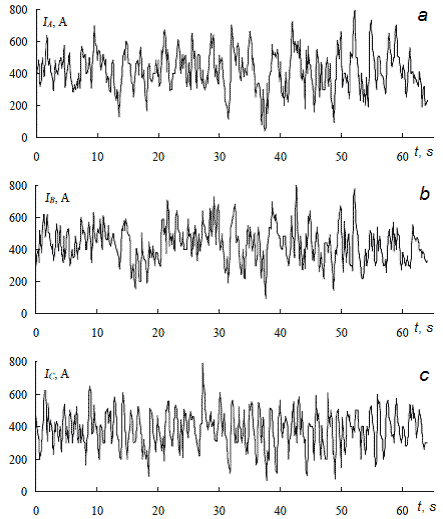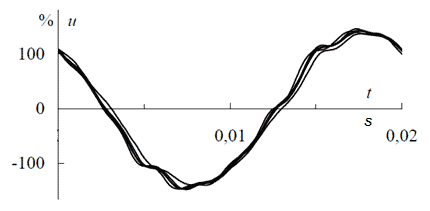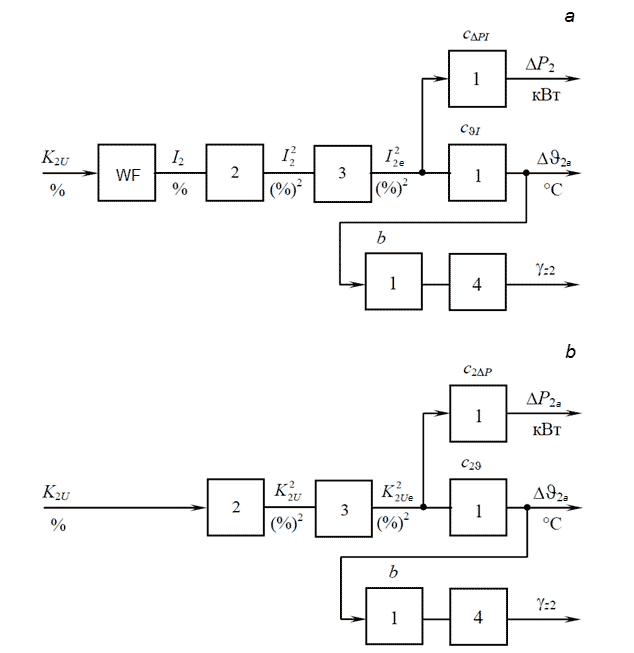

 Master's Portal
Master's Portal


|
 Master's Portal
Master's Portal
|

 About Author |
Theme of Master's Work:«Evaluation of Electromagnetic Compatibility by
|
Ensuring electromagnetic compatibility (EMC) is one of the main requirements for power supply system. Overestimation of EMC parameters leads to unfounded increase of investments and understatement – to the detriment of the additional power losses, reducing the life of electrical equipment, deterioration of product quality. In connection with this there are strong requirements on the validity and accuracy of methods for evaluating EMC at the design stage and in the operation of electricity supply systems.
Voltage unbalance is one of the most common EMC conducted emissions. In most publications, estimation of this interference is made for special cases of constant unbalance. However, in practice the unbalance varies with time, for example, when using electric arc steelmaking furnaces (EAF) (Fig. 1). [1]

This mode has a negative impact on the work of other electrical equipment, causing additional losses of active power, higher heating of current-carrying parts, premature aging of the insulation, reducing the life of electrical equipment. Therefore, the practical relevance of this master's work is to develop methods of assessing EMC.
Since the interference in existing network is a random process, there is required the development of common methods of analysis. Existing methods use static models related to the slow changes of voltage, which is not suitable for evaluation of voltage unbalance in the work of the EAF, when the voltage changes rapidly. This problem is solved using the dynamic simulation of the effects of noise on electrical equipment.
The universality of this approach is due to the lack of restrictions on the type of interference – constant, periodic or random processes can be given to the input of the model. Simulation provides the physical meaning of indicators of EMC, the unity of their measurement and calculation, the reliability of estimates of EMC. This is the scientific relevance of the work.
Thus, the main purpose of the work – the development of methods of assessing EMC. The tasks that must be addressed include:
refinement of the formulas of State Standard 13109-97 for calculating the RMS values of negative-sequence and zero-sequence component of voltage;
analysis of experimental data on unbalanced load when using EAF (definition of the statistical characteristics - the mean value, variance, current value, the distribution – by the implementation and realization ensemble);
develop the dynamic model of assessing EMC;
evaluation of EMC during the work of EAF.
Research and development of effective methods of assessing voltage unbalance studied by authors such as
Existing methods of calculating the unbalance have a large cumbersome mathematical apparatus (for a sufficiently small error), which makes their software and hardware implementation difficult or they have low accuracy (with relative simplicity), which casts doubt on the effectiveness of their use.
In addition, most scientific papers dealing with the unbalanced modes of electric networks, connected, usually with the calculation of the total losses in the elements of the network and power-consuming equipment at different levels of unbalance, as well as the development of measures that reduce the unbalance. Scientific and educational literature paid less attention to the development of methods to assess voltage unbalance, based on engineering practice and implement of their software and hardware performance
The increase in electricity losses in the network elements and electrical equipment – only one of the parties of negative impact of voltage unbalance. Another aspect of the problem – the technological damages concerned with violation of power conditions of electrical consumers. The influence of voltage unbalance on the work of consumers is affected in many papers devoted to calculations of modes of electrical networks, and is reflected in the scientific and educational literature. However, assessing the impact of voltage unbalance on the operation of electrical consumers as well as analysis of the interaction of electrical consumers with unbalanced network are complicated by numerous factors influencing the outcome (the need to take into account features of consumers and supply network, the need for information about the reasons causing the voltage unbalance). This leads to significant assumptions and reduce the reliability evaluation result of the interaction of electrical consumers and a network.
Rotating electrical machines AC can be referred to special group of consumers that are connected to public networks. This is determined by extremely high sensitivity of such consumers to voltage unbalance. The research of influence of voltage unbalance on the work of such consumers is reflected in works of many authors
It should be noted that the reduction of voltage and current unbalance is advisable, even when it is within an acceptable range, as this decreases the loss of electrical power networks and power-consuming equipment, lightens conditions of the work of generators, motors and relay protection. Therefore, balancing should be viewed not only as the means of improving the quality of electricity, but also as the means of improving efficiency and reliability of the electrical system as a whole. [2]
[3] EMC of technical equipment – the ability of technical equipment to operate at the desired quality in a given electromagnetic environment and not to cause harmful electromagnetic interference to other equipment. With regard to problems of power supply, a power supply system is the electromagnetic environment, and an electrical consumer is the technical means which takes the signal: the symmetrical and undistorted voltage. Thus, under the EMC in the narrow sense refers to the ability of electrical consumer to function normally in the electricity system and do not create in it conductive interference, that can be unacceptable to other electrical consumers.
The problems of ensuring EMC are solved at the stage of designing and exploitation, which requires the creation of methods of calculation and measurement of EMC – values which quantitatively characterize the properties of EMC. [1]
The subject of master's work – «Evaluation of EMC by voltage unbalance». In power-supply systems of industrial enterprises voltage unbalance can be caused by external and internal factors. External voltage unbalance is caused, firstly, because the generators of power stations can not create a completely symmetrical system of voltages. Secondly, lines and transformers have a spread in the resistances of the phases and the transformation ratio. Thirdly, on the neighboring plants can be situated so powerful consumers with unbalanced load, that they can create voltage unbalance in the regional power networks, of which feeds on the enterprise in question. In the designing assumes that the external voltage unbalance is absent. The source of internal voltage unbalance is a three-phase power-consuming equipment with unbalanced load (EAF, etc.), as well as single-phase power-consuming equipment. As a result, even in the absence of external unbalance, voltage Ug on the buses will be unbalanced, since unbalanced load creates in resistance of network unbalanced loss of voltage. This violates EMC of other electrical equipment: asynchronous and synchronous motors, condenser units, craft transformers. [1]
Refinement of formulas of State Standard 13109-97. Evaluation of EMC for voltage unbalance based on the rms values of the negative-sequence  and zero-sequence
and zero-sequence  component of voltage [4]:
component of voltage [4]:


where 



 – three linear and two phase voltage measured simultaneously on the i-th observation for the period of time equal to
– three linear and two phase voltage measured simultaneously on the i-th observation for the period of time equal to
As seen from the formulas, the voltage may take indefinite values in case of disconnection of one phase (the extreme case of voltage unbalance), because the denominator of fractions  and
and  turn into 0. In connection with this formula needs clarification. [4]
turn into 0. In connection with this formula needs clarification. [4]
Baselines. The initial data for calculations of EMC are realizations (graphics) of interference (Fig. 2) or their characteristics. The existing electrical equipment recorded graphics take into account all the specifics of the network, electrical equipment, the presence of external interference. Loads’ graphics of sources of noise – either calculated or obtained experimentally for similar sources of interference are being used in designing. [1]

In this paper, initial data are obtained in the mode of fusion waveforms of voltages and currents of asynchronous motors (AM) installed in steelmaking plant «Dneprospetsstal».
In general, network, power-consuming equipment and means of improving EMC presented by equivalent circuits with lumped parameters: combination of active resistance, inductance and capacitance. External and internal noise are taken into account separately. For external noise used design scheme in which sources of interference are considered as sources of EMF: no matter how varied the parameters of electrical conditions and the sources of internal interference, external interference graph remains unchanged.
Finding the graph of internal interference sources of interference considered to be sources of current with load-invariant with respect to any changes in the network. In connection with this equivalent circuit (Fig. 3) is a parallel connected current sources  power-consuming equipment and network. Obstacle is the voltage between points а and b.
power-consuming equipment and network. Obstacle is the voltage between points а and b.

For low-power power supply systems sources of interference can not be considered as current sources, and we should proceed from the principle of invariance of the individual conductances, which do not depend on changes in network modes. In this case, the loads of noise sources are dependent, which complicates the calculations.
If there are multiple sources of interference calculations are done on the graphics of sum of active and sum of reactive components of currents.
Noncyclical noise is usually specified as a trellis function: a discrete sequence of ordinates with small step of sampling  along the time axis. Periodic noise can be presented in the form of a Fourier series. [1]
along the time axis. Periodic noise can be presented in the form of a Fourier series. [1]
Block diagram of the dynamic model of EMC for the voltage unbalance. In general, the dynamic model of EMC of electrical consumer contains weighting filter (WF) that simulates the reaction and block of quadratic inertial smoothing (QIS) (Fig. 4, a). In the proportional block 1 with a coefficient of transmission  enters quadratic current inertial process
enters quadratic current inertial process 

In the absence of information about the parameters of the WF or in the consolidated technical and economic calculations, when only coefficients  are known, dynamic model of masses electrical consumers adopted in the form shown in Fig. 4, b. Here to the link 1 comes the inertial process
are known, dynamic model of masses electrical consumers adopted in the form shown in Fig. 4, b. Here to the link 1 comes the inertial process  after quadratic inertial smoothing of coefficients of an unbalance.
after quadratic inertial smoothing of coefficients of an unbalance.
In general, the network connects a group of electrical consumers with different time constants of heating. Their dynamic models will vary by the value of the parameter Т of QIS unit.
Average power losses  are calculated by the squared effective value of negative sequence of current
are calculated by the squared effective value of negative sequence of current  . For getting this value after square-ware generator 2 there provides a link 3 for determining the mean value (Fig. 5, a). In the proportional link 1 is multiplication
. For getting this value after square-ware generator 2 there provides a link 3 for determining the mean value (Fig. 5, a). In the proportional link 1 is multiplication  by a factor
by a factor 
The average power loss is proportional to the square of the effective value of  coefficient of unbalance, therefore:
coefficient of unbalance, therefore:

The corresponding dynamic model is presented in Fig. 4, b. The link 1 of this dynamic model has the transfer coefficient 
Similar models for estimating the average temperature differ only in the transmission coefficients of proportional links. The average temperature is an indicator of EMC for electrical consumers with a very large thermal inertia (in theory T  ). In general case, reducing the life time of electrical equipment is determined by the average temperature. To do this, the models in Fig. 5 provides a proportional link 1 with a transmission coefficient b and the exponential link 4.
). In general case, reducing the life time of electrical equipment is determined by the average temperature. To do this, the models in Fig. 5 provides a proportional link 1 with a transmission coefficient b and the exponential link 4.

Electric arc steelmaking furnaces operating in a network, creates voltage unbalance, which affects the work of all consumers are included in this network. Therefore it is necessary to develop methods to assess voltage unbalance. However, existing methods are based on static models, which can not describe the rapid random changes of voltage that occur when using EAF. The solution is to use dynamic models of EMC.
At the time of writing the summary master's work was not completed. The final work can be obtained from the author or scientific adviser after December 2010.
ГОСТ 30372-95. Межгосударственный стандарт. Совместимость технических средств электромагнитная. Термины и определения. – Введ. 01.01.1997.
ГОСТ 13109-97. Межгосударственный стандарт. Электрическая энергия. Совместимость технических средств электромагнитная. Нормы качества электрической энергии в системах электроснабжения общего назначения. – Введ. в Украине с 01.01.2000.